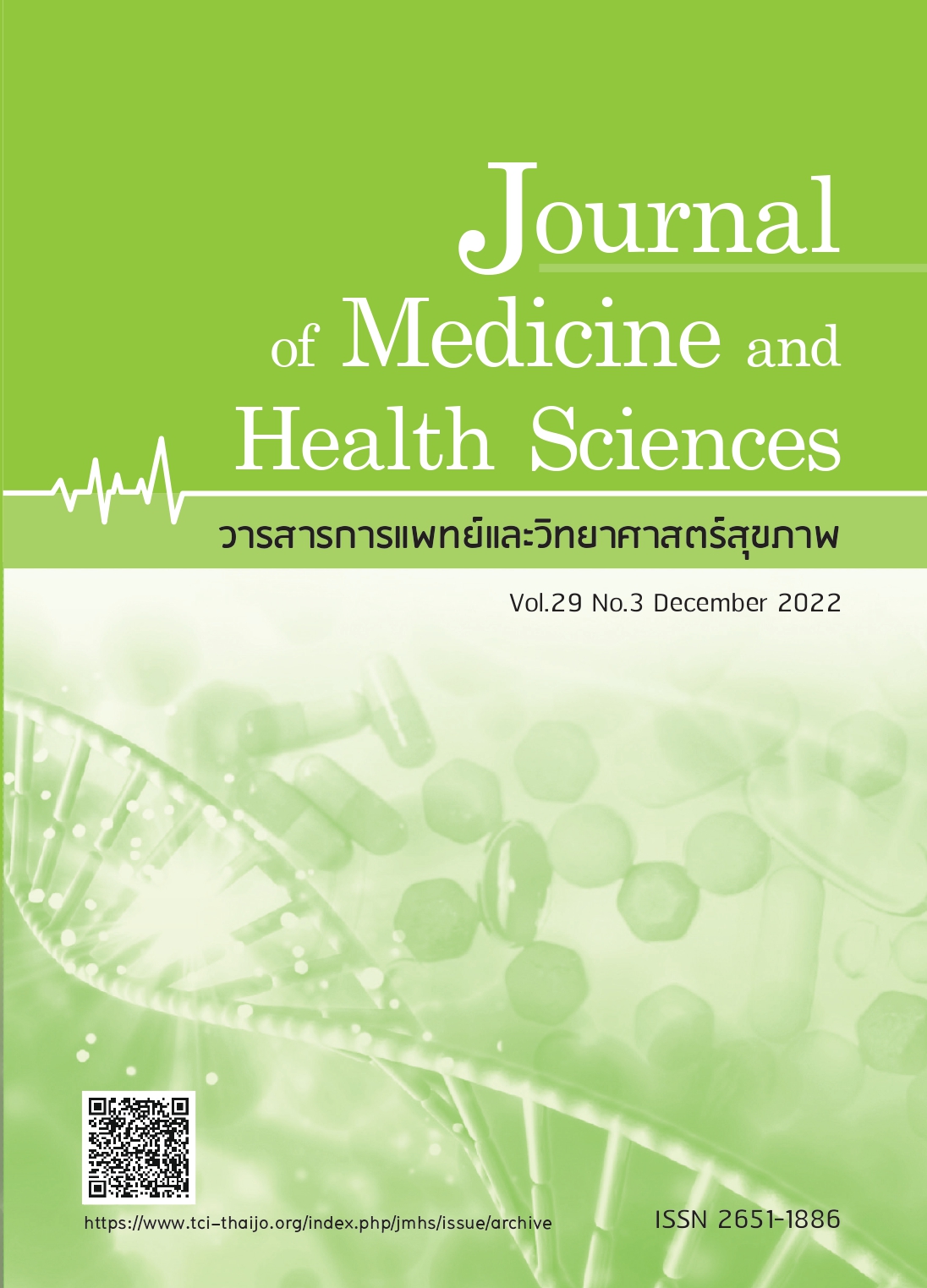Incidence of Diabetic Ketoacidosis in the Emergency Room, Hatyai Hospital
Keywords:
Hyperglycemia, Diabetic ketoacidosis, Emergency roomAbstract
Abstract
Diabetic ketoacidosis (DKA) is a metabolic complication of diabetes mellitus, characterized by a biochemical triad of hyperglycemia, ketonemia, and metabolic acidosis. This is potentially fatal, especially for the elderly and comorbid patients. The objective of this study was to assess the incidence of DKA in the emergency room at Hatyai Hospital by a retrospective chart review of patients, who were 18-year-old and diagnosed with hyperglycemia or DKA from ICD 10. The analysis covered incidence, clinical features, laboratory results, and the disposition of the patients. The outcomes were reported as the number, ratio, percentage, and median. The results showed that 269 patients were eligible for inclusion in the study. The mean age was 56.2-years-old and most subjects had type 2 diabetes (88.8%) with a mean blood sugar level of 468.2 mg/dL. The DKA incidence was 20.8%, with all of them treated as inpatients and the patients admitted to the general ward (40.3%) and the ICU (85.7%). There was a significant increase respiratory rate, pulse rate and serum potassium. Human insulin is the most current treatment in DKA group (33.1%). Most of all patients came to the emergency room by themselves (51.7%), but there was a high incidence rate of DKA in patients who came with the emergency medical services (EMS) (33.3%). The most comorbid disease was hypertension (34.41%). All of the DKA patients fulfilled the diagnostic criteria of the 2009 criteria from The American Diabetes Association, including high blood sugar, wide anion gap metabolic acidosis, ketonemia or ketonuria with significant differences in the non-DKA group. In conclusion, the hyperglycaemic patients in the emergency room had a significant incidence of DKA less than simple hyperglycemia, but they would have severe consequences if not treated. Therefore, its still necessary to investigate all patients with hyperglycemia. As there were a variety of factors related to the diagnosis, there still needs to be further studies and to find additional relevant factors to determine hyperglycemic patients that could lead to patient care development and appropriate use of limited resources including the improvement of an emergency medical system to reach more people.
References
Davis SN, Umpierrez GE. Diabetic
ketoacidosis in type 2 diabetes mellitus -
pathophysiology and clinical presentation.
Nat Clin Pract Endocrinol Metab 2007;3:
-1.
Nyce A, Byrne R, Lubkin CL, et al. Chapter
: Diabetic ketoacidosis 9th ed. Chapel
Hill, NC: Mc-Graw Hill; 2020. p.1433-41.
Kitabchi AE, Umpierrez GE, Miles JM, et al.
Hyperglycemic crises in adult patients
with diabetes. Diabetes Care 2009;32:
-43.
Umpierrez G, Korytkowski M. Diabetic
emergencies - ketoacidosis, hyperglycaemic
hyperosmolar state, and hypoglycemia.
Nat Rev Endocrinol 2016;12:222-32.
French EK, Donihi AC, Korytkowski MT.
Diabetic ketoacidosis and hyperosmolar
hyperglycemic syndrome: A review of
acute decompensated diabetes in adult
patients. BMJ 2019;365:l1114.
Dhatariya K, Savage M. The management
of diabetic ketoacidosis in adults. 2nd ed.
United Kingdom: Joint British Diabetes
Societies (JBDS);2013.
Kitabchi AE, Wall BM. Management of
diabetic ketoacidosis. Am Fam Physician
;60:455-64.
Misra S, Oliver NS. Diabetic ketoacidosis
in adults. BMJ 2015;351:h5660.
Moraes AG, Surani S. Effects of diabetic
ketoacidosis in the respiratory system.
World J Diabetes 2019;10:16-22.
Zhong VW, Juhaeri J, Mayer-Davis EJ.
Trends in hospital admission for diabetic
ketoacidosis in adults with type 1 and 2
diabetes in England. 1998-2013:a
retrospective cohort study. Diabetes Care
;41:1870-7.
Henriksen OM, Roder ME, Prahl JB, et al.
Diabetic ketoacidosis in Denmark incidence
and mortality estimated from public
health registries. Diabetes Res Clin Pract
;76:51-6.
Hanas R, Lindgren F, Lindblad B. Diabetic
ketoacidosis and cerebral edema in
Sweden -- a 2-year pediatric population
study. Diabetic Med 2007;24:1080-5.
Hekkala A, Knip M, Veijola R. Ketoacidosis
at diagnosis of type 1 diabetes in children
in northern Finland temporal changes
over 20 years. Diabetes Care 2007;30:861-6.
Rocky M, Pereira JR, Oliveira AM, et al.
Ethnicity and young age influence the
frequency of diabetic ketoacidosis at the
onset of type 1 diabetes. Diabetes Res
Clin Pract 2007;78:259-62.
Benoit SR, Zhang Y, Geiss LS, et al. Trends
in diabetic ketoacidosis hospitalizations
and in-hospital mortality - United States,
-2014. MMWR 2018;67:362-5.
Anthanont P, Khawcharoenporn T,
Tharavanij T. Incidence and outcomes of
hyperglycemic crises: a 5-year study in a
tertiary care center in Thailand. J Med
Assoc Thai 2012;95:995-1002.
Ginde AA, Pelletier AJ, Camargo CA. The
national study of U.S. emergency department
visits with diabetic ketoacidosis, 1993-2003.
Diabetes Care 2006;29:2117-9.
Handelsman Y, Henry RR, Bloomgarden
ZT, et al. American association of clinical
endocrinologists American college of the
endocrinology position statement on the
association of SGLT-2 Inhibitors and
diabetic ketoacidosis. Endocr Pract 2016;
:753-62.
NCD Risk Factor Collaboration. Worldwide
trends in diabetes since 1980: a pooled
analysis of 751 population-based studied
with 4.4 million participants. Lancet
;387:1513-30.
Davies MJ, D’Alessio DA, Fradkin J, et al.
Management of hyperglycemia in type 2
diabetes, 2018. A consensus report by the
American diabetes association (ADA) and
the European Association for the study of
Diabetes (EASD). Diabetes Care 2018;41:
-701.
Downloads
Published
How to Cite
Issue
Section
License

This work is licensed under a Creative Commons Attribution-NonCommercial-NoDerivatives 4.0 International License.



